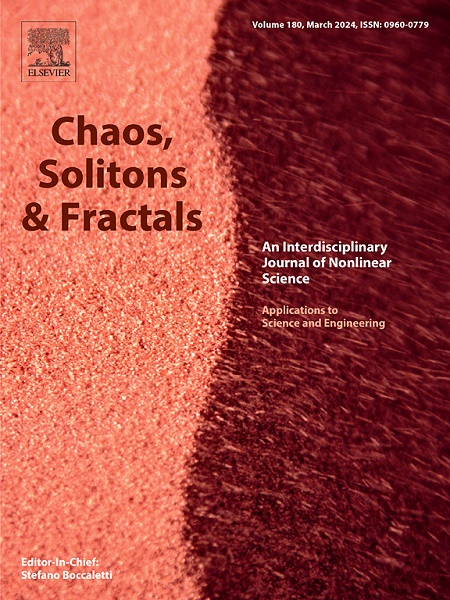Jacobi stability and aperiodicity of Rikitake-Hide model based on KCC-theory
IF 5.6
1区 数学
Q1 MATHEMATICS, INTERDISCIPLINARY APPLICATIONS
引用次数: 0
Abstract
The fluctuations of sunspots as an index of solar activity have an 11-year cycle and secular variation with grand minima. The basic features of fluctuations of sunspots are reproduced as fluctuations of magnetic energy using the Rikitake-Hide model, a coupled Faraday disks model combining the Rikitake and Hide models. This study discusses the Jacobi stability and aperiodicity of the Rikitake-Hide model using the second and third invariants in the KCC (Kosambi–Cartan–Chern) theory. The second and third KCC-invariants provide the Jacobi stability and aperiodicity (discrepancies) in the system and are expressed by the electric current and angle velocities in the model. From the calculations from the KCC-invariants, the Rikitake model that accounts for most of the magnetic energy is Jacobi unstable when the magnetic energy takes local minima. The aperiodicity of the electric–current trajectory in the Rikitake model does not accumulate over a long time, and the cycle behavior of magnetic energy basically persists because of the symmetric change in the electromagnetic field of the model. Meanwhile, the aperiodicity due to the Hide model intermittently reduces the amplitude of the magnetic energy and increases its cycle length. Especially, large aperiodicity due to the Hide model as a disturbance makes the trajectory in the Rikitake model take an unusual path at local minima that is Jacobi unstable, causing large-scale grand minima of magnetic energy without reversal of the magnetic field. Therefore, the Jacobi stability and aperiodicity are key factors in the behavior of the magnetic energy in the Rikitake-Hide model.
基于kcc理论的Rikitake-Hide模型的Jacobi稳定性和非周期性
太阳黑子的波动作为太阳活动的一个指标,其周期为11年,长期变化伴有极小期。利用Rikitake-Hide模型(一种结合Rikitake模型和Hide模型的耦合法拉第盘模型)将太阳黑子波动的基本特征再现为磁能波动。本文利用KCC (kosambii - cartan - chern)理论中的第二和第三不变量讨论了Rikitake-Hide模型的Jacobi稳定性和非周期性。第二和第三个kcc不变量提供了系统的雅可比稳定性和非周期性(差异),并由模型中的电流和角速度表示。由kcc不变量计算可知,当磁能达到局部极小值时,占磁能大部分的Rikitake模型是不稳定的。Rikitake模型中电流轨迹的非周期性不会长期积累,由于模型电磁场的对称变化,磁能的周期行为基本保持不变。同时,Hide模型引起的非周期性间歇性地降低了磁能的振幅,增加了磁能的周期长度。特别是Hide模型作为扰动引起的大非周期性使得Rikitake模型中的轨迹在局部极小值处走一条不寻常的路径,这是Jacobi不稳定的,导致了没有磁场反转的大尺度磁能极大极小值。因此,在Rikitake-Hide模型中,Jacobi稳定性和非周期性是影响磁能行为的关键因素。
本文章由计算机程序翻译,如有差异,请以英文原文为准。
求助全文
约1分钟内获得全文
求助全文
来源期刊

Chaos Solitons & Fractals
物理-数学跨学科应用
CiteScore
13.20
自引率
10.30%
发文量
1087
审稿时长
9 months
期刊介绍:
Chaos, Solitons & Fractals strives to establish itself as a premier journal in the interdisciplinary realm of Nonlinear Science, Non-equilibrium, and Complex Phenomena. It welcomes submissions covering a broad spectrum of topics within this field, including dynamics, non-equilibrium processes in physics, chemistry, and geophysics, complex matter and networks, mathematical models, computational biology, applications to quantum and mesoscopic phenomena, fluctuations and random processes, self-organization, and social phenomena.
 求助内容:
求助内容: 应助结果提醒方式:
应助结果提醒方式:


